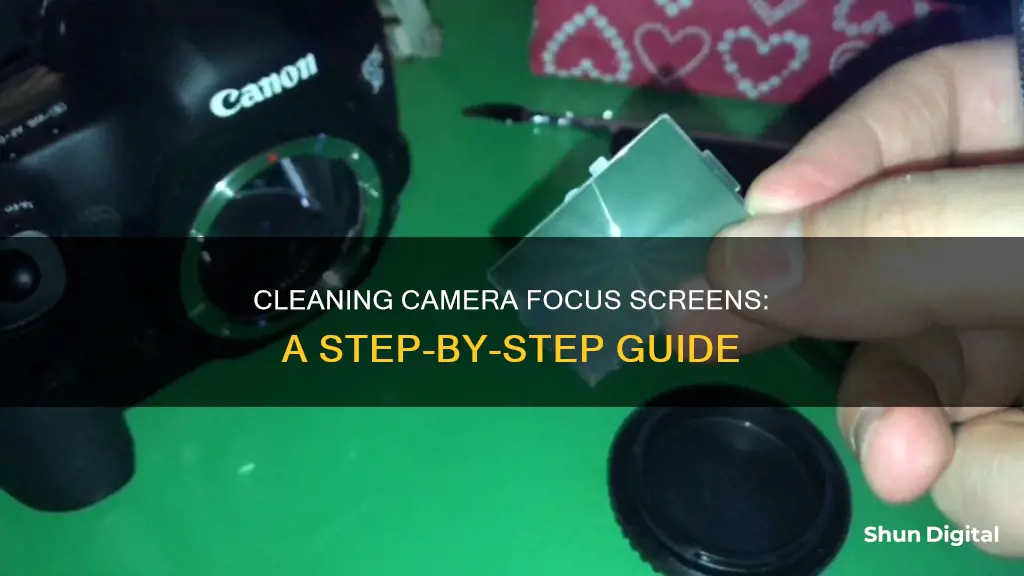
Keeping your camera's focus screen clean is essential for capturing clear, crisp images. Over time, dust and dirt can build up, and if you're using an older camera, you might also have to deal with decaying foam from mirror bumpers and light seals leaving residue on the screen. While cleaning the focus screen can be tricky, depending on your camera's design, it's definitely possible to do it safely and effectively. Here's a step-by-step guide to help you clean your camera's focus screen without causing any damage.
| Characteristics | Values |
|---|---|
| Ease of cleaning | Depends on the camera design and type of focus screen |
| Tools | Rocket blower, soft brush, distilled water, lens cloth, tweezers, hair dryer, paper towel, isopropyl alcohol, detergent, compressed gas, hairblower, lint-free tissue |
| Precautions | Avoid touching the screen with fingers; handle by the edges; avoid chemicals and solvents; avoid rubbing, polishing or applying pressure; keep at least 12 inches away from the hair dryer |
What You'll Learn

Use a blower brush to remove dust
A blower brush is an effective tool for cleaning camera focus screens, especially when dust has accumulated on the lens. This 2-in-1 tool features a blower and a soft brush, allowing you to remove dust without physical contact. Here are some tips on how to use a blower brush to clean your camera focus screen:
- Ensure you have the right blower brush: While blower brushes are generally similar, some are designed specifically for cleaning camera equipment. These are often made with high-quality rubber and feature a soft brush.
- Prepare your workspace: Before you start cleaning, ensure your workspace is clean and free of dust. This will help prevent additional dust from settling on your camera's focus screen during the cleaning process.
- Remove the focus screen: Depending on your camera model, you may need to remove the focus screen for cleaning. Refer to your camera's manual to determine if and how the focus screen can be removed. Be very gentle during this process, as the focus screen is made of soft plastic and can scratch easily.
- Use the blower: Gently blow air onto the focus screen to remove dust particles. Be sure to cover the side hole of the blower bulb with your thumb when squeezing to create a more powerful airflow.
- Detach the brush: If dust remains after blowing, detach the brush from the blower. The brush can be used to gently wipe away any remaining dust particles. Be careful not to apply too much pressure, as this may damage the focus screen.
- Reattach the focus screen: Once you have finished cleaning, carefully reattach the focus screen according to the instructions in your camera's manual.
- Test your camera: After cleaning and reassembling, test your camera to ensure the focus screen is functioning properly.
Remember to always handle your camera's focus screen with care and avoid using liquids or chemicals unless specifically recommended by the camera manufacturer.
Charged Camera Battery: Know-How
You may want to see also

Wash with distilled water
When cleaning a camera focus screen, it is important to note that the screens are very delicate and can be easily scratched. It is recommended to only use distilled water to clean the screen, as other liquids may contain impurities that could damage the screen. Here is a step-by-step guide on how to effectively clean your camera's focus screen using distilled water:
Step 1: Prepare the distilled water
Before you begin, make sure you have a small bowl or container filled with distilled water. Distilled water is pure and free of any impurities, which makes it ideal for cleaning sensitive equipment like camera focus screens.
Step 2: Remove the focus screen from the camera
Refer to your camera's manual to safely remove the focus screen. Be extremely gentle and cautious during this process, as the focus screen is fragile and can be easily damaged. Hold the screen by its edges to avoid leaving fingerprints or accidentally applying pressure to the surface.
Step 3: Clean the focus screen with distilled water
Using distilled water, gently rinse both sides of the focus screen. You can do this by holding the screen under a gentle stream of distilled water or by dipping it briefly into a container of distilled water. Avoid using any brushes, cloths, or other abrasive tools, as they may scratch the screen. If necessary, you can use a gentle stream of distilled water to remove any stubborn dirt or debris.
Step 4: Dry the focus screen
After rinsing the focus screen, gently shake off any excess water. You can also use a hair dryer set to low heat or a rocket blower to speed up the drying process. Ensure that you hold the dryer or blower at least 12 inches away from the screen to avoid applying direct heat.
Step 5: Reassemble the camera
Once the focus screen is completely dry, carefully place it back into the camera, following the instructions in your camera's manual. Be careful not to touch or rub the screen during this process.
Step 6: Test the camera
After reassembling the camera, attach the lens and test the focus screen to ensure it is clean and functioning properly.
It is important to note that while distilled water is a safe and effective method for cleaning camera focus screens, it may not remove all types of stains or dirt. In some cases, a small amount of dish soap or isopropyl alcohol may be necessary to completely remove stubborn residue. However, always exercise caution when using any chemicals near your camera equipment, and be sure to rinse thoroughly with distilled water afterward.
Shipping Camera with Battery: Europe-Specific Guide
You may want to see also

Dry with a rocket blower
Once you have cleaned your camera's focus screen with distilled water, it is important to dry it properly. One way to do this is to use a rocket blower. This is a safe method as it avoids the use of any chemicals or liquids that could damage the screen.
Rocket blowers are a great tool for camera owners as they can be used to clean various parts of the device. They are particularly useful for focus screens, as they can be very delicate and prone to scratches. When drying your focus screen with a rocket blower, be sure to hold it at least 12 inches away from the screen to avoid any potential damage.
It is also important to note that different types of focus screens require different cleaning methods. Some screens are removable, while others are not. Additionally, some screens are made of multiple layers, which can be tricky to clean without getting liquid in between the layers. Always consult your camera's manual to determine the best cleaning method for your specific focus screen.
While a rocket blower is a great tool for drying and cleaning your camera's focus screen, it is important to be gentle and careful during the process to avoid any accidental damage.
Where to Buy Camera Batteries: CVS Options
You may want to see also

Avoid using chemicals
When cleaning a camera focus screen, it is important to avoid using chemicals. Many focus screens are made of soft plastic that can be easily scratched or damaged by liquids and household cleaners.
The matte Fresnel side of the focus screen is particularly sensitive and will be ruined by chemicals. This side has finely cut grooves that can be flattened by rough cleaning methods, so it is important to handle it with care.
Instead of using chemicals, it is recommended to use a blower brush, a soft brush, or a rocket blower to remove dust and dirt. If something is stuck to the screen, breathe on it and gently use a cotton bud to remove the particle.
If the screen is extremely dirty and requires a more thorough cleaning, distilled water can be used. However, it is important to be extremely gentle when applying water to the screen. Use clean fingers to apply a small amount of low pH dishwashing liquid to the screen, being careful not to put too much pressure on the screen. Rinse the screen with distilled water and blow it dry with a cold air blower.
In summary, when cleaning a camera focus screen, it is important to avoid using chemicals and to opt for gentler methods like blower brushes and distilled water to prevent any damage to the sensitive surfaces of the screen.
Understanding Slave Mode Functionality on Cameras
You may want to see also

Be gentle
When cleaning a camera focus screen, it's important to be gentle. These screens are often made of soft plastic, which can scratch easily, so you should avoid using any brushes, cloths, or other tools that could cause abrasion. Instead, opt for a gentle touch with clean hands or tools specifically designed for cleaning camera equipment, such as a lens cloth or clean tweezers.
If you need to apply liquid to the screen, always use distilled water or a specialised cleaning solution, as regular water may contain minerals that can leave spots or residue on the screen. Even with distilled water, avoid rubbing or applying pressure to the screen, and instead, gently wick away any large droplets with a paper towel or soft, lint-free cloth.
Compressed air can also be used to blow away dust and dirt, but be cautious not to blow moisture onto the screen. If using a hairdryer to speed up the drying process, set it to low and maintain a distance of at least 12 inches from the screen to avoid overheating.
In some cases, you may need to remove the focus screen from your camera for effective cleaning. This can vary depending on the camera model, so it's important to refer to your camera's manual for specific instructions. When handling the screen, always hold it by the edges to avoid touching the surfaces.
Remember, the focus screen is delicate, and it's better to be cautious than to apply too much force and risk damaging it.
Charging Lorex Cameras: Quick and Easy Guide
You may want to see also
Frequently asked questions
It depends on how dirty it is. If dust and dirt in the viewfinder are distracting, you may have no choice but to clean it.
You will need a microfiber cloth, distilled water, a blower brush, and a soft-bristled brush.
First, remove the focus screen from your camera. Then, use a blower brush to remove any dust. Next, gently brush the screen with a soft-bristled brush. Finally, rinse the screen with distilled water and dry it with a microfiber cloth.







